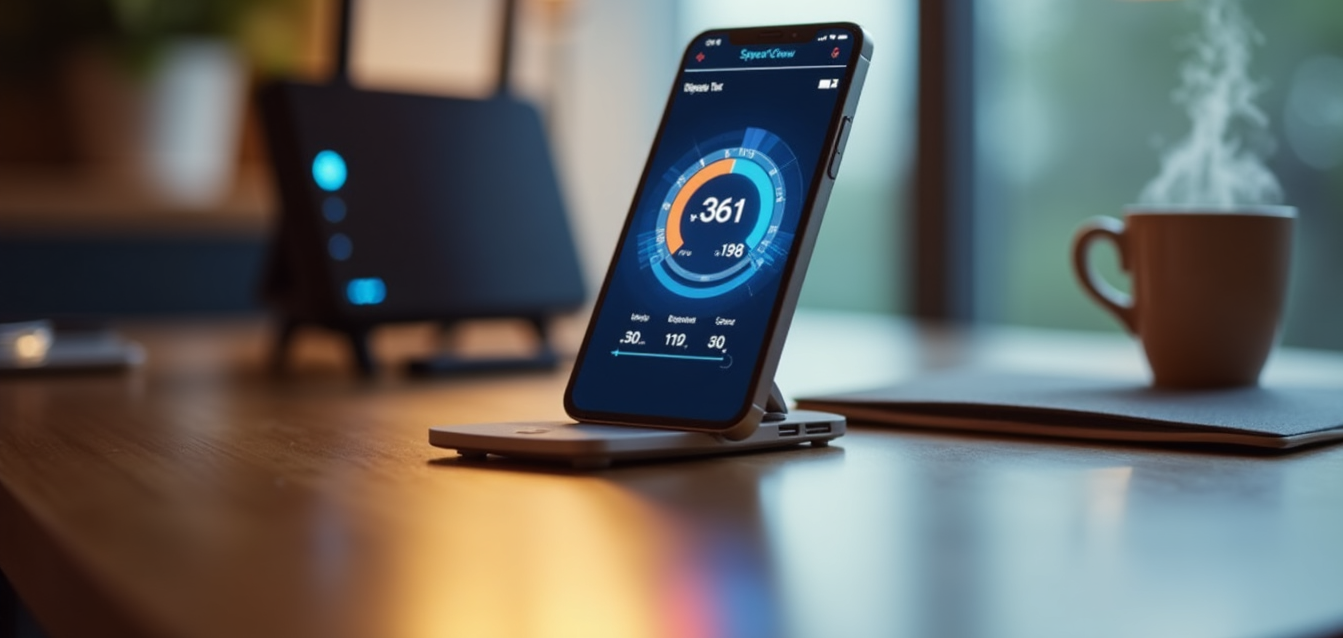Quick and Easy: Speed Check Telstra Internet in Minutes

A reliable internet connection has become crucial to our daily lives. We depend on it for work, entertainment, and staying connected with others. Telstra customers often need to check their connection speeds, particularly when their service seems slower than usual. A quick speed test can tell you if you’re getting the internet speeds you’re paying for.
Let me show you how to accurately test your Telstra internet speed using both Wi-Fi and ethernet cable connections. You’ll learn the right way to prepare for testing, run the speed check, and make sense of your results. We’ll also look at ways to fix common problems that slow down your NBN or mobile broadband. Your connection speed can change because of signal strength, physical obstacles, and interference from other devices. Understanding these factors helps you get the most from your service.
Prepare Your Device for Accurate Testing
Getting accurate results from your Telstra internet speed check needs some preparation. A few easy steps will help you avoid common issues that mess up test accuracy.
Make sure you’re testing the right connection at the time of checking. If you’re using a mobile device, check that you’re connected to your Wi-Fi network and not mobile data [1].
Here’s what you need to do to get the best test conditions:
- Stop any downloads and streaming that’s running [2]
- Shut down apps that use data in the background [2]
- Take other devices off the network if you don’t need them [3]
- Use an ethernet cable instead of Wi-Fi to get steady results [3]
- Run tests outside peak hours (not between 7 PM-11 PM) [3]
Your modem’s quality and age can affect your connection speeds by a lot. You might want to upgrade to a Telstra Smart Modem if you have older equipment to get the best broadband performance [4].
Slow speeds on one device could mean you have malware or viruses. You can check this easily by testing your connection on another device – faster speeds on the second device mean your first one needs some tech help [4]. The best way to get accurate results is to run multiple tests throughout the day since network speeds change based on how many people are using it [5].
Run the Telstra Speed Test
A Telstra speed test takes less than a minute to complete [6]. Users can choose from several trusted testing platforms like Speedtest by Ookla, Fast.com, TestMy.net, and Speedof.Me [2].
The speed test process involves these simple steps:
- Open a web browser and go to a speed testing platform
- Click the “Go” or “Start” button to initiate the test
- Wait for the test to complete its measurements
- Review the results displayed on screen
The test evaluates important metrics: download speed (how fast data is received), upload speed (how fast data is sent), and ping rate (connection latency) [6]. These speeds use megabits per second (Mbps) as their measurement unit, where 1 Mbps equals 1 million bits transferred each second [2].
Users should connect their device to the modem or router through an ethernet cable to get accurate results [6]. The server’s location affects test results significantly – nearby servers produce better performance [7]. Regular testing at different times throughout the day helps monitor performance effectively [6].
Telstra Internet’s current average performance shows download speeds of 72.89 Mbps and upload speeds of 14.36 Mbps, with a ping latency of 56 ms [8]. The actual speeds might vary because of signal strength, weather conditions, and network capacity [9].
Interpret Your Speed Test Results
Speed test results help you learn about your Telstra internet performance compared to your plan’s specifications. Telstra offers several NBN speed tiers with different performance levels:
- NBN 25: 25Mbps download, 5Mbps upload
- NBN 50: 50Mbps download, 20Mbps upload
- NBN 100: 100Mbps download, 20Mbps upload
- NBN 250: 250Mbps download, 25Mbps upload
- NBN 1000: Up to 700Mbps download, 50Mbps upload [10]
Your download speeds should be faster than upload speeds during result interpretation [10]. Latency shows how responsive your connection is and gets measured in milliseconds (ms). Games and video conferences work better with lower latency numbers [10].
Your connection type substantially affects the speeds you can achieve. Fiber-to-the-Node (FTTN) connections might deliver speeds nowhere near 50Mbps [10], while Hybrid Fiber Coaxial (HFC) users can reach downloads of 275-280Mbps [11]. Heavy rain and weather conditions can affect FTTN, FTTC, and Fixed Wireless connection performance [9].
Network congestion, signal strength, and physical barriers cause speed variations throughout the day [9]. You should run multiple speed tests at different times to understand your connection’s typical performance levels.
Troubleshoot Common Speed Issues
Internet speeds can slow down due to various factors that affect connection performance. Wi-Fi signal strength largely depends on where you place your modem and the physical barriers present in your home [4].
Common Sources of Interference:
- Microwave ovens and cordless phones
- Baby monitors
- Metal or concrete walls
- Large water sources (like fish tanks)
- Dense wooden furniture [4]
Better connection speeds require proper modem placement. The ideal location should be central and raised to desk height, not on the floor or near the ceiling [12]. Keep the device away from thick walls and solid objects that might block signals [12].
Speed tests in different locations can help identify problem areas if your home has connection issues in specific spots [12]. You can find bandwidth bottlenecks by turning off unnecessary data-hungry devices when multiple devices are connected [4].
Speed problems with a single device need testing with a different, newer device to determine if the issue lies with the device itself. Older devices might not support faster speeds or could have malware problems [4]. Your modem’s quality and age substantially affect its performance – Telstra suggests using their Smart Modem to get the best broadband performance [4].
Speed issues often disappear after a simple modem restart. Just unplug the power cable for 10 seconds, plug it back in, and wait 1-2 minutes for the system to stabilize [13].
Conclusion
Speed testing helps Telstra customers get the best internet performance. You can monitor your connection quality and spot problems by testing correctly and understanding the results. These tests show how well your network performs and whether it matches your plan’s promised speeds and meets your daily needs.
Smart fixes and the right modem placement will keep your internet speeds consistent throughout your home. Better connection reliability and performance come from following these testing and optimization steps. Your internet service quality stays at its best when you regularly check speeds and maintain your network properly.
FAQs
How can I determine my current internet speed?
To find out your internet speed, you can use online speed tests such as the one provided by Telstra or SpeedTest.net. These tests measure the speed that reaches your device, which may be lower than your plan’s advertised speed due to factors like WiFi conditions and device capabilities.
What are the typical internet speeds for Telstra?
Telstra typically offers internet speeds of about 250Mbps for downloads and 22Mbps for uploads during peak hours from 7pm to 11pm.
How can I check the strength of my Telstra WiFi signal?
To assess your Telstra WiFi signal strength, log into My Telstra with your Telstra ID, navigate to ‘Get help’, select ‘Internet’, and then choose ‘Test my connection’ or the ‘get help’ option.
What is the method to check internet speed in my locality?
You can use online tools like Speedtest to check the speed and performance of your internet connection from any device for free.
Is the download/upload speed I’m getting with my new Telstra NBN normal compared to my previous cable speed?
If you find that your new Telstra NBN speeds are slower than your previous cable connection, it might be worth discussing this with Telstra to ensure everything is set up correctly and functioning as it should.
My internet speed has drastically reduced recently, what should I do?
If your internet speed has significantly dropped and remains consistently low despite having a strong WiFi signal, it’s advisable to contact Telstra support. Ensure that your router is functioning correctly and not just receiving but also effectively distributing the internet speed across your devices. If the issue persists without resolution, consider further troubleshooting steps or possibly escalating the matter within Telstra’s support framework.
References
[1] – https://www.telstra.com.au/small-business/online-support/internet/test-internet-speed
[2] – https://www.geeks2u.com.au/geekspeak/how-to-run-an-internet-speed-test-a-step-by-step-guide/
[3] – https://speedtest.telstra.com/
[4] – https://www.telstra.com.au/support/internet-and-home-phone/improve-internet-and-home-phone-speeds
[5] – https://www.cnet.com/home/internet/best-speed-tests/
[6] – https://www.testmyspeed.com/insights/internet-speed-test-results-explained
[7] – https://www.finder.com.au/broadband-plans/telstra-broadband/how-fast-is-telstra-internet
[8] – https://www.broadbandspeedchecker.co.uk/isp-directory/Australia/telstra-internet.html
[9] – https://www.telstra.com.au/internet/nbn/nbn-speeds-explained
[10] – https://www.reviews.org/au/internet/telstra-speed-test/
[11] – https://www.reddit.com/r/Adelaide/comments/v4ovmh/howcanigethelpwithterriblyslowtelstra_nbn/
[12] – https://www.telstra.com.au/support/internet-and-home-phone/telstra-smart-modem-support
[13] – https://www.telstra.com.au/support/internet-and-home-phone/restart-modem-and-network-connection-device

